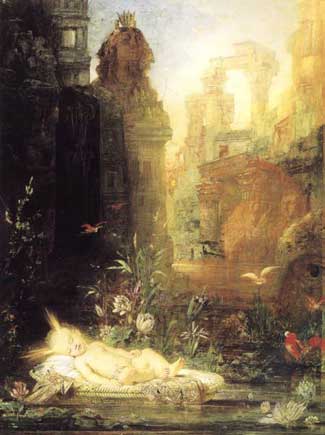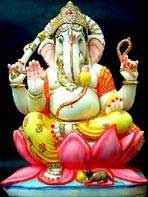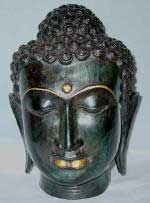2006 03 20
By Hiro Manukian

Moses by the Nile, Painting Date: 1878, Location: Fogg Art Museum, Harvard University, Cambridge, Massachusetts, USA
|
In all ancient indigenous myths and traditions there are occurrences of the "idea" that certain advanced beings, earthly or otherwise, have the ability to bestow some sort of miraculous "nektar" for the sacred or spritual benefit of the local society.
On the face of it the modern day person would assume that what is being referenced are psycho-tropic drugs- obtained from plants and so on, and although the practice of consuming drugs has been with the human species almost from the beginning it is in actuality not what is referred to in the case of the "Nektar of the Gods".
In ancient Sumerian, Egyptian, Roman and Greek myths and legends the Nektar is actually an "excretion" from the organism of the God- the Christian Eucharist, which sources its form from prehistoric Egypt is a "dramatic re-enactment" of the myth of the Nektar of the Gods- which in that case is incorporated in the Blood and Flesh of the God- however, the most ancient aspects of this myth do not place the Nektar directly in the Blood or Flesh but rather in excretions delivered from the Eyes, mostly from the Ears and in some cases the Mouths of the Gods!

Ganesha, The Elephant is sacred due to its large ears and its large tooth (tusks) |
I have discovered cases, from ancient Mayan descriptions where the Nektar is excreted from the mouth through extraction of a tooth of the God whence instead of blood there is a clear fluid which is excreted- this substance was regarded as sacred and very powerful, providing a type of immortality, which allowed the local society, or consumers of the sacred substance, to be able to travel to the home of the Sky Gods after physical death. This sounds very similar to the Christian Eucharist. I think both are speaking about the Soul and about something real.
In my research concerning the Pharoes and other ancient God-Kings and the mythology of the Nektar of the Gods and the sacred benefit to the local society it is this Nektar, or the ability of the "king" to dispense the Nektar, which is at the basis of Kingship.
There is always some striking mythology concerning the "birth" of the King. I place the "birth" in quotes because strangely enough I have discovered that in the majority of instances the major mythological event of childhood occurs at roughly the age of four- it is always after the physical birth and some years later that a series of events occurs which leads to the mythological 'crises' which is regarded as the true spiritual birth, so to speak. For example the story of Moses sent down the Nile in a basket- this occurred at age four.
In actual fact this type of story is universal concerning the ancient God Kings. In the story of Christ we again have this aspect. though it is placed at his physical birth with the Star of Bethlehem. and then later with the baptism of Jesus when he was an adul.t at which time the Dove descended and he was born into his fullness as a "God-King".
The story of King Arthur is another example of this mythological archetype- it has all the elements. The genetic descendent of a real king, associated with a Dragon ( a symbol of the aerial vehicle of the Gods) who is removed from his inheritance as a baby for safety and education as a normal human child. Later the child begins his real education with Merlin- and later the event of the Sword in the Stone when the child becomes the God King. The Nektar is referenced through the Grail Cup- though in the original story there is an incident where Arthur loses a baby tooth and Merlin is very careful in making sure that the tooth is kept safe.

Buddha- enlarged ears |
In the mythology of the Buddha, again we see the same overall story of the life of one of the God Kings. In ancient Buddhistic texts and iconography it is the Ears which are related to the Nektar or the bestowal of the King-ship- the clear fluid, Amritsar, flowed from the Buddha's ears and of course in the iconography his ears are always enlarged. But yet again, his baby teeth were also regarded as extremely sacred and figure in many myths about his life.
This is just a brief outline of my thesis. I am at present I am still researching and compiling a book on the subject.
Regards,
Hiro Manukian
Article received from Hiro Manukian
Related: Mind Food of the Gods, collected works by and about Terence McKenna
Link to the Highest Source and Drink the Magic God Nectar
Maya treasure found in Guatemala
